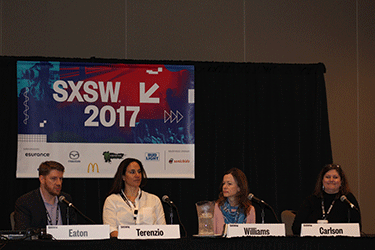 “If you’re strapped for talent, you need to jump in and try something new,” said Heather Terenzio, president, Techtonic Group, during a panel about tech apprenticeships at SXSW. The panel focused on creative ways in which government and private entities can work together to develop robust apprenticeship programs providing on-the-job training to help solve the growing IT skills gap.
“If you’re strapped for talent, you need to jump in and try something new,” said Heather Terenzio, president, Techtonic Group, during a panel about tech apprenticeships at SXSW. The panel focused on creative ways in which government and private entities can work together to develop robust apprenticeship programs providing on-the-job training to help solve the growing IT skills gap.
Terenzio’s software development company started coding apprenticeships about three years ago, after a chance meeting with a man who had come out of the child foster system. He had been teaching himself coding for about 10 years but had never had the economic stability to go to college and pursue an IT career. Up until that point, Techtonic, like many IT companies, had been mainly recruiting college or coding boot camp graduates. Terenzio decided to take a chance on the man and created an apprenticeship program. That chance hire blossomed into a core principle for her company.
“I went to an Ivy League university, but I didn’t learn coding there. I learned coding on the job,” Terenzio said. She explained how apprenticeships offer the same opportunity to people who can’t afford college, but, even better, it’s a system that gives back and creates loyal employees along the way.
“Apprenticeships and how we recruit foster kids and veterans are now part of our company culture,” Terenzio said. “It’s so integrated into our daily thought-process that it’s a differentiator for pitching new business.”
When asked how she finds apprentices, Terenzio said, “We recruit through social media and local workforce centers and non-profits. For our last four-week class, we had 200 applicants for 15 openings. We’ve already filled our next four classes. Our apprentices are paid $15 an hour.”
Another panelist Ardine Williams, vice president, global talent acquisitions, Amazon Web Services, said that AWS Academy works with two partners to help educate their apprenticeships and that the pay for the apprentices increases as they go through certain “phase gates” in the apprenticeship.
Williams said companies need to plan ahead and anticipate the jobs needs they’ll have six months from now. “The pieces to enact an apprenticeship are already there. You just need to decide to do it,” Williams said.
Panelist Jennifer Carlson, executive director, WTIA Workforce Institute and Apprenti, recommended, “The first step is never HR in starting an apprentice program. You need to find a champion in the tech department, who is experiencing the pain point of not having enough skilled staff.”
Apprentices are a protected job class, so there is some legal paperwork to handle. Carlson said, “That’s why Apprenti came about, since we can handle the paperwork for both large and small companies.”
Apprenti is setting up apprenticeships in Washington State for local employers, but has plans to expand to expand to six other states. Williams said a formal and more detailed announcement should be available soon.
The Apprenti apprentices’ salary is 60 percent of what a full-time employee would receive but the salaries go up as the apprentice moves through the program.
Carlson said the tech industry can’t wait while the traditional university system catches up. “In Seattle, we’re desperate for data scientists,” she said. “For a college to create a program and have it accredited and graduate people, it can take four years. In tech, our needs can drastically change in four years.”
When asked why apprenticeships and not internships, Carlson answered, “The internship model is only as good as the company that created the internship. Other companies don’t know if you learned what you needed at that internship, so they still require one or two years of experience.”
Carlson said, “Some apprenticeships are 600 hours of classroom time. That’s fairly equal to the time spent in your junior and senior years of college, but you’re getting education that directly relates to your employment, plus the valuable experience that graduates need to get their first job.”
Moderator Charles Eaton, CEO, Creating IT Futures, and executive vice president, social innovation, CompTIA, relayed how much more progressive Europe is with internships and asked panelists how the U.S. could get to that same level. Eaton discussed how a new national levy in the U.K. is being put on businesses based on the salaries they pay, but the businesses can recoup that money if they have apprenticeships.
Carlson said that in Switzerland, 75 percent of young adults go to college and 25 percent go into apprenticeships and there’s no stigma around that status.
Williams asked how we can get over the stigma in the U.S. “We need to shift the country and as parents to the thinking that all paths are created equal,” Williams said.
Eaton said, “Creating IT Futures’ research found that two to one parents are the biggest influencers on teens’ careers. We need parents to be more informed about what a tech career is like and how to get there.”
To that end, Eaton released his new book, How to Launch Your Teen’s Career in Technology: A Parent’s Guide to the T in STEM, at SXSW. The book busts the myths about tech careers and how to get into the industry, and then outlines various pathways, including apprenticeships, that teens can take.

